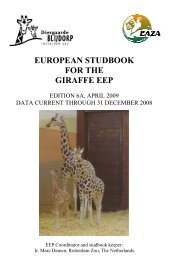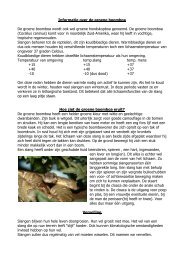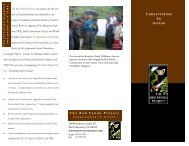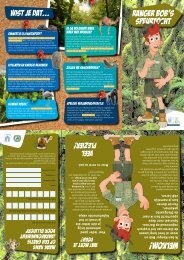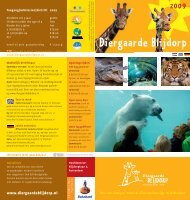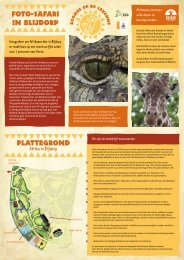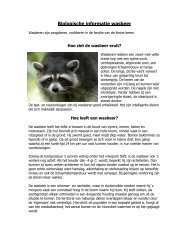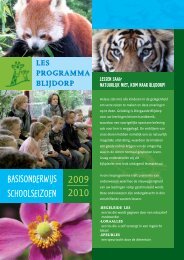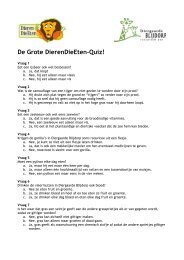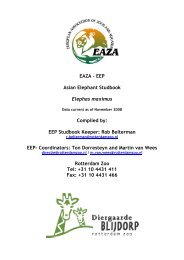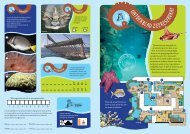Create successful ePaper yourself
Turn your PDF publications into a flip-book with our unique Google optimized e-Paper software.
<strong>EEP</strong> STUDBOOK CROWNED PIGEONS<br />
History of the island of New Guinea<br />
Approximately 150 million years ago a southern landmass known as Gondwanaland started to<br />
break up and its pieces drifted apart. Although this landmass included Antarctica, the climate<br />
was far from polar and in fact this supercontinent had a well-developed fauna and flora under<br />
at least temperate conditions. After the split, the components parts of Gondwanaland became<br />
what are now known as South America, Africa, Madagascar, India, Australia, Southeast Asia,<br />
New Zealand and Antarctica. Fifty-five million years ago Australia detached itself from<br />
Antarctica and floated northwards and, as it approached the Asian continental land mass, it<br />
caused a series of mountainous islands to be pushed up out of the sea. After a long,<br />
complicated and still only partly understood geological history, these island chains joined<br />
together to form New Guinea and other islands in the region (Menzies, 1991).<br />
In the middle Tertiary (Miocene), the first vestige of the landmass was lifted above sea level,<br />
but it was not until the great mountain-building phase of the Pliocene (5-6 million years ago)<br />
that major portions of the island as we now know them, became established. New Guinea is<br />
the product of an interaction between the northward moving Australian tectonic plate and the<br />
Pacific plate, a movement that began in the middle Mesozoic. Forceful collision between the<br />
two plates in the Tertiary is the probable cause for the mountain-building phase that produced<br />
the complex of Central Ranges (Beehler, et al., 1986). For one or more periods during the ice<br />
ages when sea levels were much lower than they are now, Australia was actually joined to<br />
New Guinea and final separation only came less than one million years ago, with the<br />
formation of the Torres Strait (Menzies, 1991).<br />
Marsupials and monotremes and many other elements of the New Guinea fauna probably had<br />
their origin in this ancestral southern land mass and were able to spread from Australia into<br />
the newly emerging New Guinea and other islands, which were connected to Australia by<br />
means of a land-bridge (Pratt, 1981), which is submerged now. On the other hand, other kinds<br />
of mammals may have had their origin in a northern land mass and were cut off from the<br />
southern continents until these land masses floated sufficiently close (about 15 million years<br />
ago) for opportunistic invasions to take place. For this reason the islands, which formed<br />
the‘collision zone’ between Australia and south-east Asia, including New Guinea, have been<br />
a mixing place for marsupials and other kinds of mammals.<br />
However, the New Guinean avifauna is predominantly Australian, since the island was<br />
actually part of the continent for the most of its history (Pratt, 1981). The native mammal<br />
fauna of the island of New Guinea is depauperate, meaning that many kinds of mammals<br />
found in adjacent regions of the world are lacking here. New Guinea’s mammal fauna is made<br />
up, apart from flying foxes and other kinds of bats, of two kinds of monotremes, and<br />
approximately equal <strong>number</strong>s (around 60) of species of marsupials (pouched mammals) and<br />
rodents but this conceals the fact that the marsupials are far more diverse. The rodents are<br />
represented by just one family: rats and mice (Muridae).<br />
On the other hand there are seven families of marsupials ranging from tiny mouse-sized<br />
carnivores to large, herbivorous kangaroos. In Australia the composition of the endemic<br />
terrestrial mammalian fauna is just the same: monotremes, marsupials and rodents, but the<br />
rats and mice are now quite out<strong>number</strong>ed by more than 120 species of marsupials in 13<br />
separate families. There are 6 different families of bats in New Guinea as well but bats have<br />
fewer restrictions on their movements and many kinds are very widely distributed outside the<br />
region (Menzies, 1991).<br />
85



